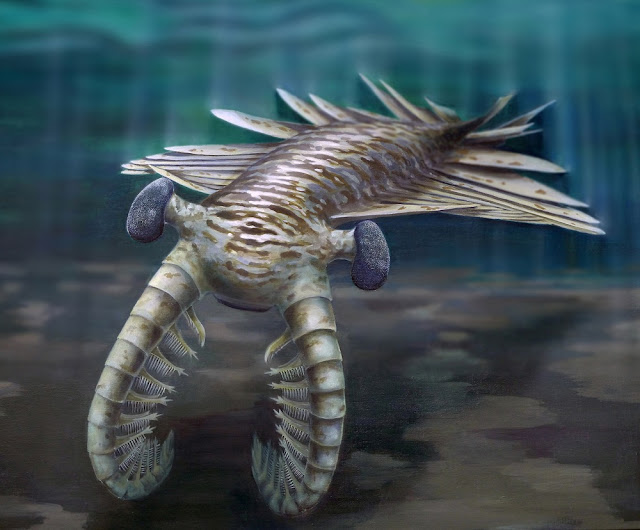Apart from writing about technology following the footsteps of Ubuntu Linux development and it's future, I'm an archaeologist and therefore you will find interesting archaeology articles at this site. I'm so much interested in deep past of planet Earh wondering what kind of world was it back half a billion years ago, what kind of animals walked it's surface and swim it's seas. Thanks to paleontology and combined forces of archaeologist as well, we can peace together an amazing story of our planet and it's amazing prehistoric times. In this installment I bringing top 5 prehistoric predators that once roomed the planet Earth. I shall note that this is a article on demand as response to Miloš Miladinović review of the movie 'Jurassic World 2015'.
Written by: Amar Tufo.
17. April, 2017
You can also see my trailer for this article: 'Top five prehistoric predators that once roamed the Earth'.
1. Anomalocaris
Anomalocaris or abnormal shrimp is considered to be the Earth first super predator that swim the Cambrian seas some 541 million years ago. This predator with long body up to length of 2 m and unique pair of eyes for night hunting suggest that Anomalocaris was indeed top predator that mostly hunted smaller trilobites and other sea animals. Fossilized remains of this animal were found across the globe in Canadian Burgess Shale formation, Australia, China and across the United States before becoming extinct some 485 million years ago at the beginning of Ordovician era.
2. Megalograptus
Image credit: http://lenta-vremeni.ru
On the prehistoric Earth, life was flourishing in the seas for as much as 350 million years. Among the seas predators comes Megalograptus a fierce scorpion predators from eurypterid family that lived during Ordovician era around 445 million years ago. Having been as on the first creatures to step on to dry land, Megalograptus was probably a night hunter preying upon smaller orthocones, trilobites and early fishes. It's fossilized remains were mostly find trough United States before being extinct in Ordovician mass extinction event around 455 million years ago.
3. Brontoscorpio
Image credit: https://wynnteresting.wordpress.com
Meet Brontoscorpio, monstrous sea scorpion of the Silurian period some 440 - 417 million years ago. This monster scorpion sweam the Silurian seas alongside Cameroceras, Cephalaspis and Pterygotus. It has an armed body just like Anomalocaris and stinger with size of a light bulb. It can grew up to one meter in length and probably feed on trilobites and Cephalaspis which was armored fish as well. Fossilized remains of Brontoscorpio were mostly uncovered in Trimpley and Worcestershire, England UK.
4. Dunkleosteus
Image credit: www.dkfindout.com
Dunkleosteus was a large armored fish that lived during the late Devonian period some 380 - 360 million years ago. It was named in 1958 after David Dunkle, a curator at Cleveland Museum of Natural History. Dunkleosteus was a top predator during much of Devonian period, a period known as age of fish. It was able to grew as much as 10 meter in length, had fierce bite about 8000 pounds. This predator feed on other fishes as well as other smaller Dunkleosteus which was according to some researchers a sign of cannibalism due to probably food shortage. Fossilized remains of this predator were found across North America, western Europe, northern Africa, Texas, California, Pennsylvania and Ohio. It is assumed that Donkleosteus was eventually extinct at the dawn of Carboniferous period, fourth period of Paleozoic era, around 358 million years ago.
5. Mosasaurus
Image credit: dinosaurpictures.org
Mosasaurus was a large marine reptile that lived during the Cretaceous period some 90 million years ago. Able to grew as much as 18 meter in length, this giant prehistoric monster feed on sharks, plesiosaurus, giant turtles, birds, as well as other mosasaurus. Named after Muse river in Netherlands were the first mosasaurus fossil were first discovered in 1764, and later across the globe in northern Europe, eastern Europe, Russia, Turkey, the Middle East, Canada, South America. Mosasaurus was a dominant sea predator for 40 million years ago before being extinct at the end of Cretaceous period 65 million years ago alongside the dinosaurs.
Conclusion:
Although today we knew much about prehistoric life and lifeforms on planet Earth, jet there are still dozens of species waiting to be discovered. As much as we think that Anomalocaris and Mosasaurus look the way we think they dis, on thing has to be always in our mind, it's just a speculation based on our model of reconstruction which we used to bring those beasts back from dead. Further paleontological research and archaeological digs across the globe will help us to understand the way these beasts feed, way they adopt to Earth climate changes and food supply that sustain they're enormous length is an amazing story of evolution of life on planet Earth. But thanks to fossilized records in Earth geological layers, that we can today told an amazing story of prehistoric life on Earth.
References:
1) Anomalocaris
2)BBC Walking with the monsters - Anomalocaris & Brontoscorpio
3) Megalograptus
http://www.prehistoric-wildlife.com/species/m/megalograptus.html
4) Brontoscorpio
5) Dunkleosteus
6) Sea Monsters with Nigel Marven | featuring Dunkleosteous
7) Mosasaurus





















No comments:
Post a Comment